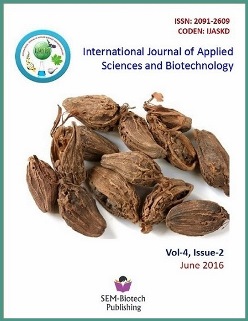In Vitro Fertilizability of Oocytes Using Fresh, Frozen and Epididymal Spermatozoa from Crossbred Bulls in the Tropics
DOI:
https://doi.org/10.3126/ijasbt.v4i2.14265Keywords:
cattle, epididymal spermatozoa, fresh semen, frozen semen, in vitro fertilizability, OocyteAbstract
The objective of the study was to examine the fertilizability of bovine follicular oocytes from abattoir ovaries using fresh, frozen and epididymal spermatozoa from crossbred bulls in the tropics. Oocytes were cultured in maturation media TCM-199 containing 25mM HEPES, 1mM glutamine L, 2.2mg/mL sodium bicarbonate, antibiotics, 22 µg/mL pyruvate, 1µg/mL estradiol-17β, 0.5µg/mL FSH and 0.06 IU hCG and supplemented with 20% heat inactivated estrus cow serum (serum collected in early estrum) at 39oC temperature, 5% CO2 tension with maximum humidity for 24 hours. Oocytes with maximum cumulus expansion were used for in vitro fertilization. Fresh, frozen and epididymal semen from crossbred bulls was used for in vitro fertilization as treatment 1(n =1690), treatment 2(n = 1620) and treatment 3(n = 1710) respectively. Control group of oocytes (1680) were treated in the same protocol along with each treatment group of oocytes in separate in vitro fertilization drop without sperm injection. The in vitro fertilization medium consisted of Fert-TALP medium supplemented with 1µM epinephrine, 10µM hypotaurine, 20µM pencillamine and 0.56µg/ml heparin. Culture conditions set for IVF were 39oC temperature, 5% CO2 tension with maximum humidity. Oocytes showing sperm penetration evidence like presence of enlarged sperm head, male pronuclei with its accompanying sperm tail in the cytoplasm, oocytes with two pronuclei and a clear second polar body but without a sperm tail were considered as fertilized. None of the oocytes in control group showed cleavage due to parthenogenetic activation. Significantly higher results of fertilization rate (p<0.05) were observed when oocytes inseminated with epididymal spermatozoa than fresh ejaculated semen followed by frozen semen.
Int J Appl Sci Biotechnol, Vol 4(2): 166-171




